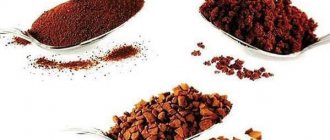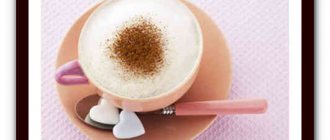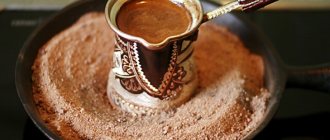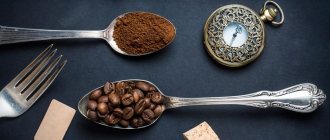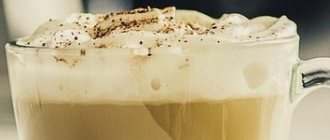The items that people initially used as containers for various drinks were far from perfect. The vessel could be an animal horn, the shell of a large bird's egg, or an amber clay product. The "dishes" were uncomfortable. The heat was not retained in it and I had to constantly hold it in my hand. On a flat surface, she fell due to instability.
Today, the confusion with mugs and cups continues to be relevant.
Soon man learned to make dishes that served him for receiving hot and cold drinks and stood steadily on a flat surface.
What are a mug and a cup
The main determining factor of how a cup differs from a mug is the parameters of the glassware. A mug is traditionally perceived as a vessel of a simple geometric shape. Often cylindrical or resembling a truncated cone. Usually cold drinks and hot ones are poured. For example, tea, juices, beer. The first hot dishes are not suitable for mugs.
In one country, the utensil for drinking tea and coffee is called a cup, because it looks more like a bowl, and in another it is called a mug.
The volume of such containers is larger. They have good stability and a handle for convenience.
Important! In different countries, both containers may perform the same functions. This is correct, but it causes confusion. In some countries, utensils intended for tea and coffee in people's understanding are cups. In other countries, a container with the same functionality is called a mug.
Related materials:
Design | cup | for home | unusual | tea | Coffee | Life Style
Articles
- Fitness during working hours November 22, 2010, 03:00
- Fashionable Christmas tree: design ideas November 29, 2010, 06:00
- Top 10 unusual slippers December 23, 2010, 00:00
Video
- Makeup for sports from Givenchy October 05, 2010, 10:58
- Thierry Wasser, perfumer of the House of Guerlain 08 September 2011, 11:52
- Night course for removing toxins from SISLEY March 25, 2013, 01:00
When were the first mugs and cups invented?
The very first cups were intended for royalty. Noble wines were poured into them. They were made from porcelain or clay. The vessel did not have a handle; its shape was flat and more like a saucer. His hands appeared in the 18th century. The idea belonged to the British. Now they could comfortably enjoy fresh, hot drinks.
When pouring your favorite drink into a mug or cup, we rarely think about the history of the two objects.
The first mugs appeared in China. The appearance of the first samples was different from modern products, but the functions remained the same. They belonged to the life of the peasants and the life of the rich class.
Similar products from the 15th century resembled mini jugs with a cylindrical shape. In the 19th century, the aluminum mug appeared and became very popular. Its volume was up to 500 ml, so it often served as a vessel for collecting water for cooking.
The mug appeared in the 19th century; it was made of light alloy so that the military could use it in the field.
Before the adoption of Christianity, in Rus' a mug was used to measure the amount of liquids (mead, water). Its volume was 1.23 liters. Clay varieties with a wide elongated shape, which lacked handles, were called “charkas” in Rus'.
How to choose paper glasses
Did you know that not all paper cups are created equal? Firstly, they are available for cold and hot drinks, only some are suitable for alcoholic drinks, and recently paper glasses are increasingly used for snacks and popcorn. First things first:
- glasses for cold drinks and ice cream are made from thin cardboard with double-sided lamination, which prevents condensation on the outer wall. This coating also allows you to apply bright designs, lamination reliably protects the colors;
- containers for hot drinks are made of denser cardboard and laminated with a thin layer of polyethylene inside the glass. The outer layer of the glass does not have lamination, which ensures a lower temperature of the outer walls of the glass, as well as the characteristic matte appearance of the glass. Such walls conduct heat slowly, making a glass of drink comfortable to hold in your hands. Used for coffee, tea, hot chocolate and other drinks;
- products for alcohol-containing drinks must be distinguished by the presence of external lamination, or not have such a coating at all, since alcohol dissolves thin polyethylene layers, which subsequently enter the body;
- glasses for popcorn, snacks and French fries are large in size, from 500 ml. In this case, the density of the cardboard and the presence of lamination do not play a role, the main thing is capacity.
Secondly, paper cups can be single-layer, double-layer or three-layer. What is the significant difference?
- Single-layer glasses are produced in volumes from 100 to 500 ml, and by volume most often we mean a comfortable volume, i.e. when the glass is not filled to the neck. They are divided into glasses for hot drinks and for cold drinks.
- Double-layer glasses are usually produced in volumes of 250, 300 and 400 ml. Used for hot drinks. The technology for producing two-layer glasses consists of an additional layer of cardboard that is placed on top of a regular glass. There is an air gap between the layers. This technology allows you to keep the drink inside a paper cup hot longer, and also does not allow the outer layer to heat up excessively. Double-layer paper cups are as convenient to use as possible, and therefore are an indispensable product for.
- Three-layer glasses, like all glasses for hot drinks, have an internal lamination, which allows the glass not to get wet, and is distinguished by the presence of two additional corrugated layers, which eliminate the formation of condensation on the glass, which contributes to good thermal insulation, thanks to which the glass retains the temperature of the drink longer and does not burns your hands.
An important characteristic of glasses is volume. Usually they indicate the useful volume, i.e. The glass may not be completely filled. Most popular volumes:
- 100ml - used for coffee prepared by coffee machines, such as espresso, Americano, etc.;
- 170ml - used in European-made vending machines, where the requirement for the glass neck diameter strictly corresponds to 70mm;
- 195ml, 205ml - used in Asian-made vending machines, where the requirement for the glass neck diameter strictly corresponds to 73mm;
- 250ml - the most popular volume, used for hot tea and coffee;
- 300ml, 400ml - used for hot and cold drinks, coffee, tea;
- 500ml - most often filled with soda, milk shakes, and recently used for mini-packs of snacks and popcorn.
It is also worth paying attention to important additional accessories for paper cups:
- Lids of various diameters, with or without a valve, help you drink your drink on the spot without the risk of staining your clothes or burning your hands;
- Some drinks are so hot that it is worth additionally using a drain - a special cuff that is put on the glass and prevents the skin of your hands from burning;
- To make it easier to carry two or more glasses, you can use stands made of environmentally friendly materials;
- Don't forget to order stirrers and drinking straws to complete the set.
What are cups and mugs made of?
Cups and mugs consist of walls of varying thicknesses. The bottom of small containers is round, horizontal on the outside. This allows you to place the products on a table or other horizontal surfaces. The cup is equipped with a handle for drinking hot drinks. Often it comes with a saucer.
Mugs can also have handles or go without them. Thick walls give a person the opportunity to calmly hold such an object in his hand at the moment when there is a scalding drink inside.
What is the difference and what is common between a mug and a cup?
There are several signs that determine the difference between a cup and a mug.
- The first difference is the difference in wall thickness. In a mug they are thicker, which allows the vessel to keep the drink hot longer. The cup has thin walls and the drink cools down faster.
- Vessels are distinguished by their volume. On average, a cup can be filled with 180 ml, which is the volume parameter of standard dishes. The container loading has a certain dependence on the drink that is poured into the container. The smallest variety has a volume of no more than 50 ml.
The cup should fit into the palm of the drinker.
A standard medium-sized mug has a volume of 250 to 500 ml.
- The cup comes complete with a saucer. This is associated with heating of the thin walls of this type of cookware. When hot tea or coffee is poured into it, the drinks are given a little time to cool. But if you don’t want to wait, the hot drink is poured into a saucer. The simplest configuration option is a wide saucer with raised edges and a cup with a flat, wide bottom, which can be conveniently placed both on the saucer and on the table.
- The mug represents a simpler vessel for daily use. Cups, if they make up a service, are bought for special occasions, served in restaurants, in cafes.
- Mugs are not associated with a separate purpose. Any drinks are poured into them in volumes suitable for the container. Cups, according to etiquette, may have certain conditions of use. Rare varieties of tea and coffee can be poured into them.
- The shape of the cup resembles a hemisphere. A mug can be distinguished by the fact that it can be compared to an elongated cylinder.
Today the vessels have the same purpose, but 100 years ago they were intended for drinking completely different drinks.
The main differences between a mug and a cup:
- The thickness of the walls of the mug is greater than that of the cup. The cups are thinner and more elegant, the tea cools faster in them
- An important difference is the volume: for a cup it is up to 180-200 ml, and a mug can be up to 500 ml
- The cup, as a rule, comes with a saucer, and the mug is sold alone. This is because when the edges of the thin cup are heated, the tea is poured into the saucer. A mug does not have such a need, so according to etiquette it is not customary to serve it with a saucer. The mug must have a handle and a stable bottom
- Antique cups have two handles on the sides. By the way, there are also modern two-handed models of cups
- Cups are more often used for ceremonial serving or in catering establishments (cafes, restaurants). Mugs are more practical and popular in daily life
- The mugs are universal and suitable for drinking any drinks in large quantities. The same cannot be said about cups: they are intended for tasting rare varieties of tea and coffee, as well as for official receptions and demonstrating respect for the guest
- The cup has a spherical shape and is lower, and the mug is always oblong or conical and tall
What can you drink from cups and mugs?
Modern culture does not set strict rules about which drinks to drink from which container. People use what is most convenient for them, what gives them comfort.
Cups for broth
Observations force us to admit that people can use both types of glassware equally, but there are times when only one type is suitable for a particular drink.
Despite the convenience, only broth can be consumed from such dishes.
For example, some cups are more suitable for hot broth. They have two handles at once. Often they are kept for only one purpose - to eat hot liquid first courses.
Beer mugs
Large mugs with a volume of more than 250 ml. are called "beer mugs". They are made of clay and glass. They have a thick handle that spans the entire height of the mug. The standard version is a faceted glass mug. They drink beer from this one.
In summer, kvass is also poured into such dishes.
Tea cups and mugs
More often at home they use standard cups and mugs intended for drinking tea or coffee. Their volume allows you to hold a small amount of aromatic hot drink. Having thin walls, they do not retain heat for long. Hot tea or coffee in a cup cools quickly. Hence the conclusion - this is a type of tableware designed for quickly drinking a hot drink.
It is advisable to give preference to high-quality earthenware or porcelain, since the thermal conductivity near the walls will be lower.
Due to its volume, the mug does not limit the consumer’s desire to enjoy hot tea or coffee longer. A person can drink his favorite drinks from a mug in large quantities. The thick walls of the mug retain the heat of the drink for a long time. In addition, a mug can be used as a vessel that allows simultaneous brewing and drinking of liquid.
The cup is more suitable for drinking small amounts of coffee and tea.
By way of example, we can identify several well-known names of coffee drinks, as well as types of tea that are drunk from tea cups. Among the coffees are espresso, latte and Americano. Today it is customary to buy tea in tea bags, which are brewed directly in a cup or in large leaf form. In the latter case, tea is brewed in a teapot, which is served separately.
The cup usually comes with a saucer.
It is recommended to use bowls for cold drinks. Sake is drunk from such vessels in Japan. You can also try Japanese vodka from bowls in Russia by visiting a Japanese restaurant. Preparing and serving sake is a whole ceremony.
It is recommended to drink cold drinks from a bowl, especially when it comes to drinking sake.
There are also ceremonies in the culture of consuming tea drinks from cups. In addition to the fact that you cannot use other utensils in them besides cups, there are rules that must be followed. The same rules unofficially exist for ordinary tea drinking.
- The teaspoon should not be in the cup during or after tea drinking.
- When grasping the tea handle with your fingers, do not bend one finger. This was only considered appropriate during the Victorian era.
Due to the high caffeine content, tea is recommended to be consumed after meals.
Types of Coffee Cups
Did you know that there are many types of coffee or tea cups and different cups are used to serve different drinks? The coffee cups were especially distinguished, which is logical, since there are a wide variety of coffee drinks. The principle of choosing coffee cups for home and for coffee shops is different, since at home you can limit yourself to purchasing a set of cups with a volume of 170-200 ml, while for a coffee shop you will need different utensils to serve each drink.
Espresso cup

An espresso cup is the smallest coffee cup, with a volume of 35-40 ml. Sometimes espresso coffee is also served in 60-90 ml cups.
The standard espresso cup is made of thick, high-quality porcelain, and this material is not just a whim for an avid coffee lover. Such cups are used to better maintain temperature, because real espresso is prepared in small portions and in any other mug it will simply cool down quickly.
Espresso cups are very heat-intensive, and their unique shape contributes to better development of the flavor bouquet. Properly brewed coffee in such a cup is drunk very smoothly, provided that the mug was preheated before pouring the coffee.
Demitasse cup
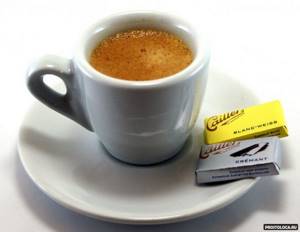
A demitasse cup is a coffee cup with a volume of 60 to 90 ml (most often) made of thick-walled porcelain in the shape of an inverted truncated cone. Translated from French, the word “demitasse” can be translated as “half cup”. Demitasse cups are also suitable for serving espresso coffee as well as Turkish coffee.
Demitasse cups are actively used when serving coffee in many famous coffee shops such as Starbucks.
Cappuccino cup
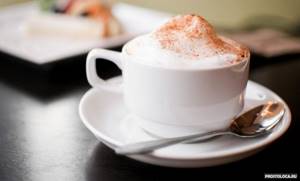
This drink requires larger cups, so coffee pairs (cup + saucer) with a volume of 170 to 220 ml are used to serve cappuccino. The smallest cappuccino cup with a capacity of 170 ml is also suitable for serving coffee drinks such as espresso with cream, lungo, dopio, etc.
Latte cup

Lattes are served in large cups or glasses of 220, 250, 300 or 360 ml.
Americano cup

An Americano coffee cup is similar to an espresso coffee cup, only larger in volume. An Americano coffee cup is a thick-walled cup with a volume of 200-220 ml.
Frappuccino cup

The largest cups are needed to serve Frappuccino. The larger the cup, the better. As a rule, this volume ranges from 350 ml to 500 ml.
If you really love coffee, then to serve drinks you will need small cups for espresso coffee, as well as standard coffee pairs for Americano and cappuccino. Large coffee cocktails can be made in glasses.
What is the correct name for a mug without a handle?
Such a mug is usually called a bowl. It represents a kind of cup without handles. It has a hemispherical or truncated conical shape. This type of tableware is used for drinks and first courses. You can store food in it.
In Europe, tea is drunk only from special bowls whose volume does not exceed 100 ml.
Bowls were known even before our era. Their origin is attributed to the second half of the 1st millennium. The first dishes of this type were made by potters from clay. Modern samples are mainly factory-made products.
A bowl is not always associated with a mug. Despite the fact that the density of its walls allows a hot drink to retain heat for a long time and the volume can be quite large. When asked what a cup without handles is, many people also call it a bowl.
In China, the volume of the bowl should not exceed 50-60 ml.
Note! The bowl has many purposes. In different countries it is used both as a vessel for tea and as a utensil for food. For example, in Asian countries it is often called an Asian tea cup or for serving rice.
Different weights in one volume
The same volume with different grinds weighs differently. A teaspoon will hold 13-16 coffee beans, which weigh on average 2.8 g. When ground into a coarse form with large particles, they will pull less than when finely ground. Therefore, the weight of the powder without a slide ranges from 3 to 4 g.
Interesting! About growing coffee at home
This difference must be taken into account when measuring with cutlery. The resulting error is not taken into account. It is completely covered by ease of use. Different variations of weight and filling are discussed in more detail in the article “How many grams of coffee are in a teaspoon and a tablespoon.”
The standard option for a 100 ml cup involves 1 tsp. soluble powder, which is poured flush with the edges. The weight will be 2.5 g. If the mug holds 150 ml, then take a heaped spoon.
What mugs do you most often drink coffee in?
SmallStandard
Features of caring for cups and mugs
Cups are usually made with a white inner coating. This is done with ordinary clay, ceramic and porcelain dishes. After drinking tea or coffee from them, a coating remains on the inner walls. The same thing happens if you drink concentrated juices from them. The dishes will look ugly. If you don’t wash it, the plaque will firmly adhere to the surface and can only be removed if you work hard with a sponge.
Thanks to the volume, you can brew tea directly in the vessel.
It is necessary to wash tea utensils immediately after they have been used for their intended purpose, without waiting a long time.
Mugs can have either a light-colored or an internal coating identical to the external design. Due to their durability, they can be washed in dishwashers in separate compartments. The same goes for other different tea utensils with thick walls.
Thin walls do not accumulate heat and allow the drink to cool quickly.
Various means are used to wash. They may vary, but should be safe for humans and have an effective cleansing result. Today, such qualities are attributed to the Fairy washing gel with a safe composition.
There are varieties of dishes that require only manual care. These are products made of porcelain. This requirement applies to all porcelain dishes. The dishwasher cannot be used in this case. Porcelain products have very thin walls. The sudden flow of water that splashes over the dishes inside the machine after switching on can damage them.
A cup is a utensil for quickly drinking a drink.
Porcelain is washed carefully in warm water with soft sponges. Then they are placed on the table upside down to drain the water. You should purchase a special absorbent towel.
